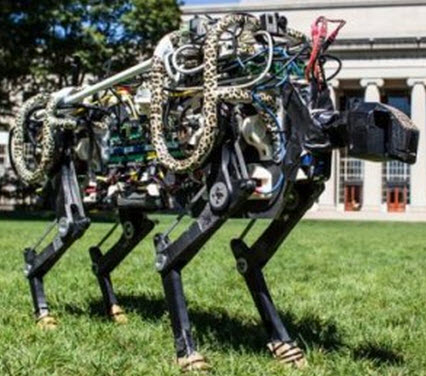What running robots can learn from turkeys
October 30, 2014
With an eye toward making better running robots, researchers from from Oregon State University, the Royal Veterinary College and other institutions have made surprising new findings about some of nature’s most energy-efficient bipeds — running birds.
These are some of the most sophisticated runners of any two-legged land animals, including humans, the researchers found in a study published Wednesday (Oct. 29) in the Journal of Experimental Biology, with an impressive ability to run while minimizing energy cost, avoiding falls or injury, and maintaining speed and direction.
What running birds can teach robots

MIT’s Cheetah robot is the world’s fastest robot, but is it the most efficient and agile? (Credit: MIT)
“Birds appear to be the best of bipedal terrestrial runners, with a speed and agility that may trace back 230 million years to their dinosaur ancestors,” said Jonathan Hurst, an associate professor and robotics expert in the OSU College of Engineering.
In the wild, an injury could lead to predation and death; and in like fashion, when food resources are limited, economy of motion is essential.
Surprisingly, a wide variety of ground-running bird species with very different body sizes use essentially the same strategy to accomplish these sometimes conflicting tasks. To hop over obstacles on uneven ground, they use a motion that’s about 70 percent a “vaulting” movement as they approach the obstacle, and 30 percent a more-crouched posture while on top of the obstacle.
In collaboration with Monica Daley at the Royal Veterinary College in London, the researchers studied five species of birds and developed a computer model in OSU’s Dynamic Robotics Laboratory that closely matches that behavior.
The researchers began the study with a hypothesis that body stability would be a priority, since it might help avoid falls and leg injuries. But that’s not what they found. Instead, running birds have a different definition of stability — they allow their upper bodies to bounce around some, just so long as they don’t fall.
Large animals like are limited by the strength of their legs because peak loads increase with body mass, and they run with somewhat straighter legs to compensate. But the basic approach large birds use to run is similar to much smaller birds, and remains highly efficient.
Modern robots, by contrast, are usually built with an emphasis on total stability, which often includes maintaining a steady gait. This can be energy-intensive and sometimes limits their mobility.
What robots could learn from running birds, the scientists said, is that it’s okay to deviate from normal steady motions, because it doesn’t necessarily mean you’re going to fall or break something. Robotic control approaches “must embrace a more relaxed notion of stability, optimizing dynamics based on key task-level priorities without encoding an explicit preference for a steady gait,” the researchers said in their conclusion.
Collaborators on the research were from the Royal Veterinary College in the United Kingdom. The work was supported by the Biotechnology and Biological Sciences Research Council in the United Kingdom and the Human Frontier Science Program.
Abstract of Don’t break a leg: running birds from quail to ostrich prioritise leg safety and economy on uneven terrain
Cursorial ground birds are paragons of bipedal running that span a 500-fold mass range from quail to ostrich. Here we investigate the task-level control priorities of cursorial birds by analysing how they negotiate single-step obstacles that create a conflict between body stability (attenuating deviations in body motion) and consistent leg force–length dynamics (for economy and leg safety). We also test the hypothesis that control priorities shift between body stability and leg safety with increasing body size, reflecting use of active control to overcome size-related challenges. Weight-support demands lead to a shift towards straighter legs and stiffer steady gait with increasing body size, but it remains unknown whether non-steady locomotor priorities diverge with size. We found that all measured species used a consistent obstacle negotiation strategy, involving unsteady body dynamics to minimise fluctuations in leg posture and loading across multiple steps, not directly prioritising body stability. Peak leg forces remained remarkably consistent across obstacle terrain, within 0.35 body weights of level running for obstacle heights from 0.1 to 0.5 times leg length. All species used similar stance leg actuation patterns, involving asymmetric force–length trajectories and posture-dependent actuation to add or remove energy depending on landing conditions. We present a simple stance leg model that explains key features of avian bipedal locomotion, and suggests economy as a key priority on both level and uneven terrain. We suggest that running ground birds target the closely coupled priorities of economy and leg safety as the direct imperatives of control, with adequate stability achieved through appropriately tuned intrinsic dynamics.
